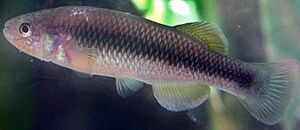Popoyote facts for kids
Quick facts for kids Popoyote |
|
|---|---|
 |
|
| Conservation status | |
| Scientific classification | |
| Synonyms | |
|
Profundulus hildebrandi Miller, 1950 |
The Popoyote (Tlaloc hildebrandi), also called the Chiapas killifish, is a special type of fish. It belongs to the Profundulidae family. This fish lives only in one small area: the valley of San Cristobal de las Casas in Southern Mexico. This makes it an endemic species, meaning it's found nowhere else in the world!
Sadly, the Popoyote is in danger. Its home, which is only a few square kilometers, is getting polluted. It's also being affected by the growth of the city of San Cristobal. People are working together to protect the wetlands where this unique fish lives.
Contents
Discovering the Popoyote
The Popoyote was first described in 1950 by a scientist named Robert Rush Miller. He found it in the closed valley of San Cristóbal de las Casas. This area is in the Chiapas region of Mexico. It's quite high up, about 2,200 meters (7,200 feet) above sea level.
The fish's scientific name, hildebrandi, honors another American fish expert. His name was Samuel F. Hildebrand.
What Does the Popoyote Look Like?
The Popoyote can grow up to 13 centimeters (about 5 inches) long. It can weigh as much as 36 grams (about 1.3 ounces).
When they are young, Popoyotes have many vertical stripes on their bodies. These stripes disappear as the fish grow into adults. Adult Popoyotes are usually grayish with green colors. Their fins are yellow.
Popoyote Life Cycle
Popoyotes start laying eggs around the end of February. They continue until the rainy season begins in June. During this time, the female fish can lay up to 150 eggs!
The Popoyote uses small channels and puddles left after the rains to lay its eggs. The eggs hatch very quickly, usually after just three days. The baby fish, called larvae, become juveniles after about three months. In less than one year, they grow into adult fish.
What Do Popoyotes Eat?
Popoyotes are helpful eaters! Their main food is the larvae and adult forms of mosquitoes. This means they help control mosquito populations. They also eat other small creatures. These include snails and other insects like beetles and dragonflies.
Images for kids



